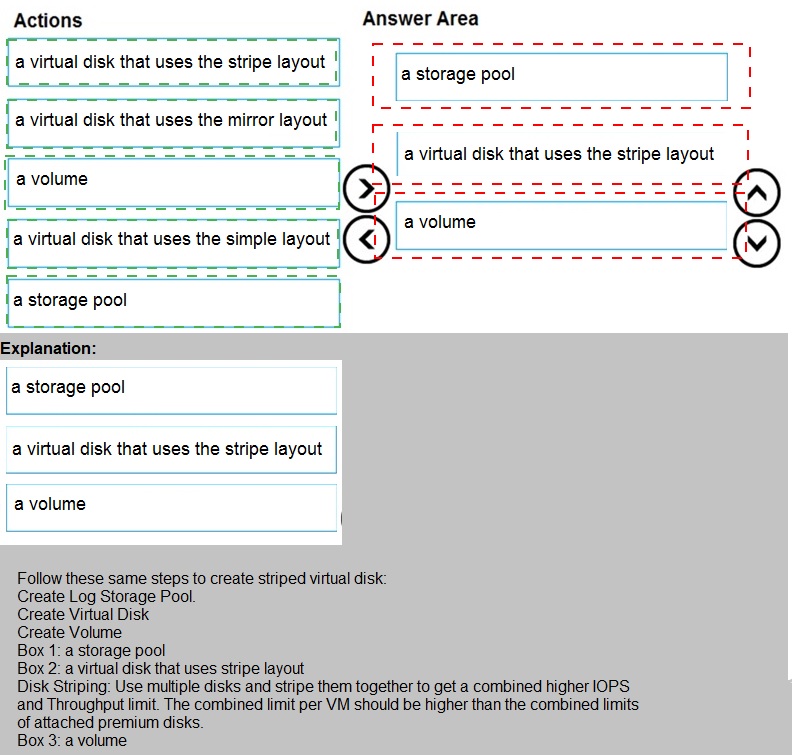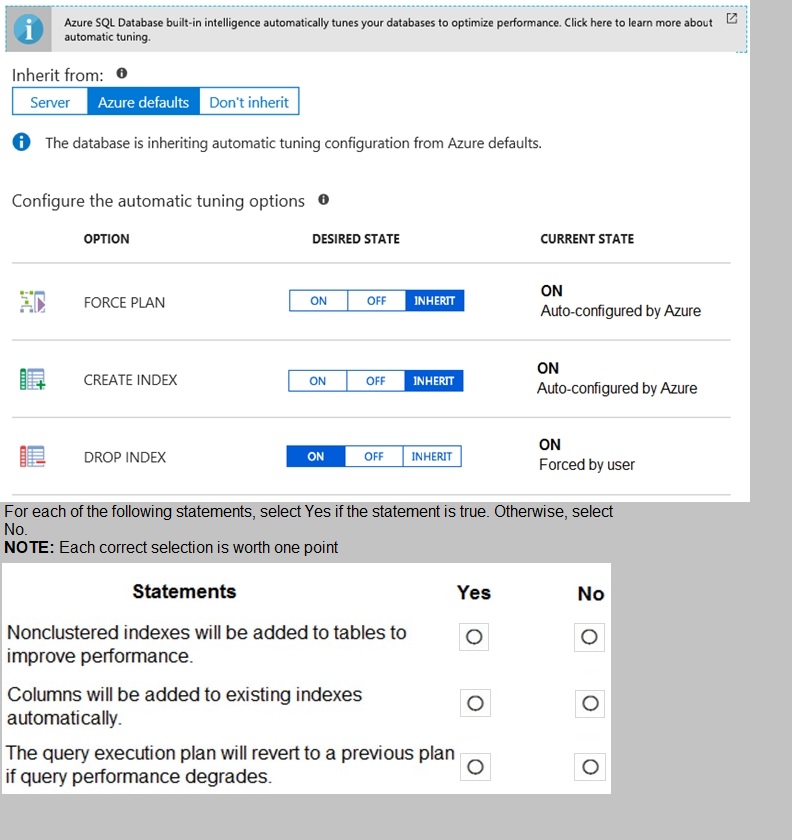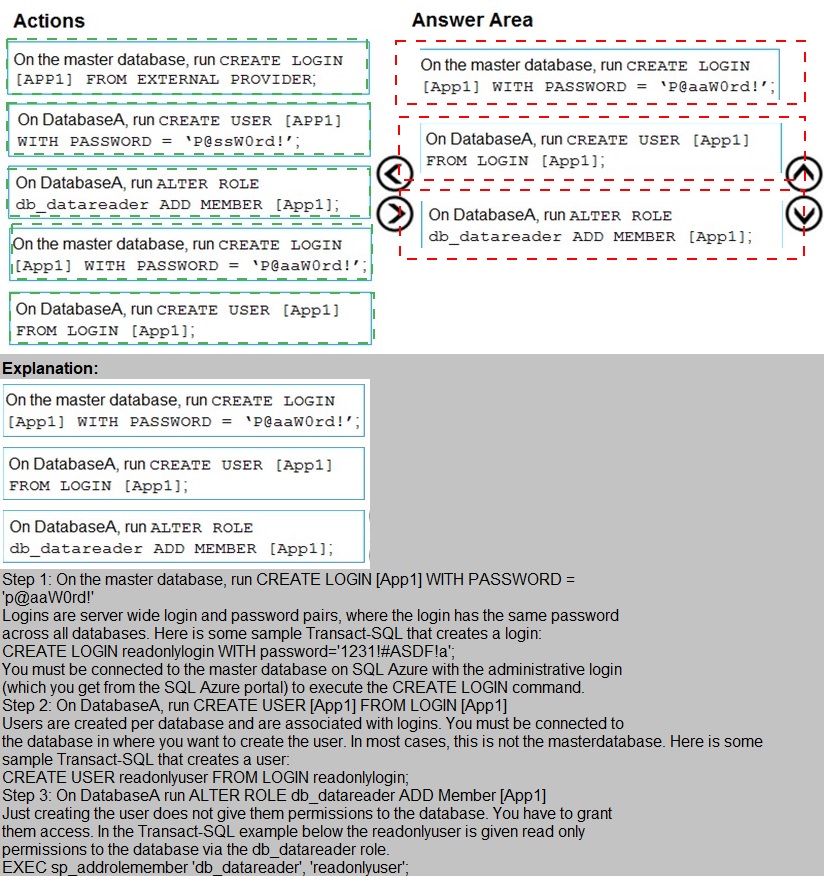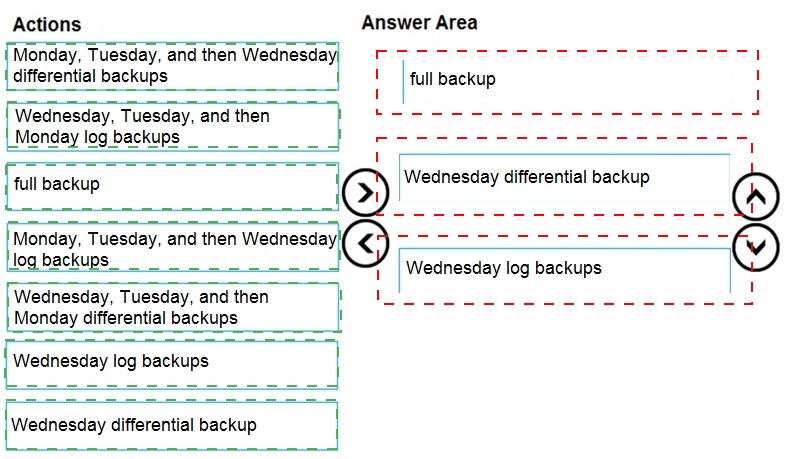Topic 5: Misc. Questions
Note: This question is part of a series of questions that present the same scenario.
Each question in the series contains a unique solution that might meet the stated
goals. Some question sets might have more than one correct solution, while others
might not have a correct solution.
After you answer a question in this section, you will NOT be able to return to it. As a
result, these questions will not appear in the review screen
You have an Azure SQL database named Sales.
You need to implement disaster recovery for Sales to meet the following requirements:
During normal operations, provide at least two readable copies of Sales.
Ensure that Sales remains available if a datacenter fails.
Solution: You deploy an Azure SQL database that uses the Business Critical service tier
and Availability Zones.
Does this meet the goal?
A.
Yes
B.
No
Yes
Explanation:
Premium and Business Critical service tiers leverage the Premium availability model, which
integrates compute resources (sqlservr.exe process) and storage (locally attached SSD) on
a single node. High availability is achieved by replicating both compute and storage to
additional nodes creating a three to four-node cluster.
By default, the cluster of nodes for the premium availability model is created in the same
datacenter. With the introduction of Azure Availability Zones, SQL Database can place
different replicas of the Business Critical database to different availability zones in the
same region. To eliminate a single point of failure, the control ring is also duplicated across
multiple zones as three gateway rings (GW).
Reference:
https://docs.microsoft.com/en-us/azure/azure-sql/database/high-availability-sla
You have SQL Server on Azure virtual machines in an availability groupYou have a database named DB1 that is NOT in the availability group.
You create a full database backup of DB1.
You need to add DB1 to the availability group.
Which restore option should you use on the secondary replica?
A.
Restore with Recovery
B.
Restore with Norecovery
C.
Restore with Standby
Restore with Norecovery
Explanation:
D18912E1457D5D1DDCBD40AB3BF70D5D
Prepare a secondary database for an Always On availability group requires two steps:
1. Restore a recent database backup of the primary database and subsequent log backups
onto each server
instance that hosts the secondary replica, using RESTORE WITH NORECOVERY
2. Join the restored database to the availability group.
Reference:
https://docs.microsoft.com/en-us/sql/database-engine/availabilitygroups/
windows/manually-prepare-asecondarydatabase-
for-an-availability-group-sql-server
You are building an Azure virtual machine.
You allocate two 1-TiB, P30 premium storage disks to the virtual machine. Each disk
provides 5,000 IOPS.
You plan to migrate an on-premises instance of Microsoft SQL Server to the virtual
machine. The instance has a database that contains a 1.2-TiB data file. The database
requires 10,000 IOPS
You need to configure storage for the virtual machine to support the database.
Which three objects should you create in sequence? To answer, move the appropriate
objects from the list of objects to the answer area and arrange them in the correct order

You have an Azure SQL database named DB1. The automatic tuning options for DB1 are
configured as shown in the following exhibit.

You have an Always On availability group deployed to Azure virtual machines. The
availability group contains a database named DB1 and has two nodes named SQL1 and
SQL2. SQL1 is the primary replica.
You need to initiate a full backup of DB1 on SQL2.
Which statement should you run?
A.
BACKUP DATABASE DB1 TO URL='https://mystorageaccount.blob.core.windows.net/
mycontainer/DB1.bak' with (Differential, STATS=5, COMPRESSION);
B.
BACKUP DATABASE DB1 TO URL='https://mystorageaccount.blob.core.windows.net/
mycontainer/DB1.bak' with (COPY_ONLY, STATS=5, COMPRESSION);
C.
BACKUP DATABASE DB1 TO URL='https://mystorageaccount.blob.core.windows.net/
mycontainer/DB1.bak' with (File_Snapshot, STATS=5, COMPRESSION);
D.
BACKUP DATABASE DB1 TO URL='https://mystorageaccount.blob.core.windows.net/
mycontainer/DB1.bak' with (NoInit, STATS=5, COMPRESSION);
BACKUP DATABASE DB1 TO URL='https://mystorageaccount.blob.core.windows.net/
mycontainer/DB1.bak' with (COPY_ONLY, STATS=5, COMPRESSION);
Explanation:
BACKUP DATABASE supports only copy-only full backups of databases, files, or
filegroups when it's executed on secondary replicas. Copy-only backups don't impact the
log chain or clear the differential bitmap.Reference:
https://docs.microsoft.com/en-us/sql/database-engine/availability-groups/windows/activesecondaries-
backup-on-secondary-replicas-always-on-availability-groups
You have an Azure SQL Database instance named DatabaseA on a server named
Server1.
You plan to add a new user named App1 to DatabaseA and grant App1 db_datacenter
permissions. App1 will use SQL Server Authentication.
You need to create App1. The solution must ensure that App1 can be given access to other
databases by using the same credentials.
Which three actions should you perform in sequence? To answer, move the appropriate
actions from the list of actions to the answer area and arrange them in the correct order.

You plan to move two 100-GB databases to Azure.
You need to dynamically scale resources consumption based on workloads. The solution
must minimize
downtime during scaling operations.
What should you use?
A.
An Azure SQL Database elastic pool
B.
SQL Server on Azure virtual machines
C.
an Azure SQL Database managed instance
D.
Azure SQL databases
An Azure SQL Database elastic pool
Explanation:
Azure SQL Database elastic pools are a simple, cost-effective solution for managing and
scaling multiple
databases that have varying and unpredictable usage demands. The databases in an
elastic pool are on a
single server and share a set number of resources at a set price.
Reference:
https://docs.microsoft.com/en-us/azure/azure-sql/database/elastic-pool-overview
You have SQL Server on an Azure virtual machine that contains a database named DB1.
DB1 is 30 TB and has a 1-GB daily rate of change.
You back up the database by using a Microsoft SQL Server Agent job that runs Transact-
SQL commands. You perform a weekly full backup on Sunday, daily differential backups at
01:00, and transaction log backups every five minutes.
The database fails on Wednesday at 10:00.
Which three backups should you restore in sequence? To answer, move the appropriate
backups from the list of backups to the answer area and arrange them in the correct order.

You have an Azure SQL managed instance named SQLMI1 that hosts 10 databases.
You need to implement alerts by using Azure Monitor. The solution must meet the following
requirements:
Minimize costs.
Aggregate Intelligent Insights telemetry from each database.
What should you do?
A.
A. From the Diagnostic settings of each database, select Send to Log Analytics.
B.
B. From the Diagnostic settings of each database, select Stream to an event hub.
C.
C. From the Diagnostic settings of SQLMI1. select Send to Log Analytics.
D.
From the Diagnostic settings of SQLMI1. select Stream to an event hub.
https://docs.microsoft.com/en-us/azure/azure-sql/database/metrics-diagnostic-telemetrylogging-
streaming-export-configure?tabs=azure-portal#configure-the-streaming-export-ofdiagnostic-
telemetry
Your company analyzes images from security cameras and sends alerts to security teams
that respond to unusual activity. The solution uses Azure Databricks.
You need to send Apache Spark level events, Spark Structured Streaming metrics, and
application metrics to Azure Monitor.
Which three actions should you perform in sequence? To answer, move the appropriate
actions from the list of actions in the answer area and arrange them in the correct order.

vYou have an Azure data factory that has two pipelines named PipelineA and PipelineB.
PipelineA has four activities as shown in the following exhib



| Page 7 out of 18 Pages |
| Previous |